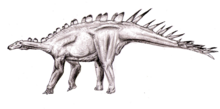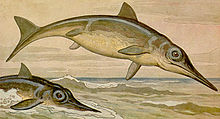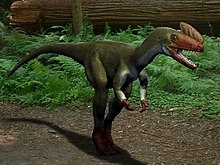This is a partial list of dinosaurs found in the United Kingdom, arranged alphabetically.[1][2]
| Genus | Picture | Period | Discovery locations and dates |
|---|---|---|---|
| Baryonyx | 
|
Cretaceous (early) | Smokejacks Brickworks, Waverley, Surrey in 1983[3]
Ewhurst Brickworks, Walliswood, Surrey in 1997[4] Redlands Bricks, Bexhill-on-Sea, East Sussex in 1997[4] Ashdown Brickworks, Bexhill-on-Sea, East Sussex in 2010[5] |
| Becklespinax | 
|
Cretaceous (early) | Battle, East Sussex in 1856[6] |
| Camptosaurus | 
|
Jurassic (late) | Chawley Brick Pits, Cumnor Hurst, Oxfordshire in 1880[7] |
| Cetiosauriscus | Jurassic (mid) | New Peterborough Brick Company, Fletton, Cambridgeshire in 1898[8] | |
| Cetiosaurus | 
|
Jurassic (mid) | 19 sites including:
Stonesfield, Oxfordshire in 1825[9] Staple-Hill, Wootton, Oxfordshire in 1841[10] Sarsden, Chipping Norton, Oxfordshire in 1888[11] |
| Dacentrurus | 
|
Jurassic (late) | Swindon Brick and Tile Company, Swindon, Wiltshire in 1874[12] |
| Eotyrannus | 
|
Cretaceous (early) | Isle of Wight in 1995[13] |
| Eustreptospondylus | 
|
Jurassic (mid) | Summertown Pit, Wolvercote, Oxfordshire in 1870[14] |
| Hylaeosaurus | 
|
Cretaceous (early) | Tilgate Forest, Cuckfield, West Sussex in 1822[15]
Stammerham Quarry, Horsham, West Sussex in 1826[16] Hakesbourne Pit, Rusper, West Sussex in 1842[17] Bolney, West Sussex in 1851[18] Ridgeway Hill, Weymouth, Dorset in 1860[19] Brixton Bay, Isle of Wight in 1874[20] Ashdown Brickworks, Bexhill-on-Sea, East Sussex in 2010[21] |
| Hypsilophodon | 
|
Cretaceous (early) | Cowleaze Chine, Isle of Wight in 1849[22]
Isle of Wight in 1979[23] |
| Ichthyosaur | 
|
Triassic to Cretaceous | Over 100 sites including:
First complete skull at Lyme Regis, Dorset in 1811[24] Complete skeleton at Rutland Water, Rutland in 2021[25] |
| Iguanodon | 
|
Cretaceous (early) | Over 60 sites including:
First discovery (tooth) at Tilgate Forest, Cuckfield, West Sussex in 1822[15] |
| Mantellisaurus | 
|
Cretaceous (early) | Rockhill Quarry, Maidstone in 1834[26]
Atherfield, Isle of Wight in 1917[27] Smokejacks Brickworks, Waverley, Surrey in 1956[28] Chilton Chine, Isle of Wight in 1976[29] Grange Cline, Isle of Wight in 1989[30] |
| Megalosaurus | 
|
Jurassic (mid) | Over 30 sites including:
Lower femur at Stonesfield, Oxfordshire in 1676[31] and over 100 further bones there from at least 7 individuals by 1911[32] |
| Metriacanthosaurus | 
|
Jurassic (late) | Jordan's Cliff, Weymouth, Dorset in 1871[33] |
| Neovenator | 
|
Cretaceous (early) | Brighstone Bay, Isle of Wight in 1978[34] |
| Pantydraco | 
|
Jurassic (early) | Pant-y-ffynnon Quarry, Bonvilston, Vale of Glamorgan in 1952[35] |
| Pelorosaurus | 
|
Cretaceous (early) | Cuckfield Quarry, West Sussex in 1822[36] |
| Polacanthus | 
|
Cretaceous (early) | 12 sites (9 on Isle of Wight, 2 in Sussex, 1 in Essex) including:
First discovery (partial skeleton) at Barnes High, Isle of Wight in 1865[38] Another partial skeleton at Barnes High in 1979[39] |
| Proceratosaurus | 
|
Jurassic (mid) | Minchinhampton, Gloucestershire in 1910[40] |
| Saltopus | 
|
Triassic (late) | Partial skeleton at Lossiemouth Quarries, Elgin, Moray in 1867[41] |
| Sarcosaurus | 
|
Jurassic (early) | Partial skeleton at Barrow-on-Soar, Leicestershire in 1921[42] |
| Scelidosaurus | 
|
Jurassic (early) | Partial skeletons at Charmouth, Lyme Regis, Dorset in 1850s[45], in 1955[46] and in 1985[47]
Seatown, Dorset in 1987[48] |
| Thecodontosaurus | 
|
Triassic (late) | Durdham Down, Bristol in 1834[49]
Microlestes Quarry, Frome, Somerset in 1871[50] Holwell, Frome, Somerset in 1889[51] Ruthin Quarry, Glamorgan in 1957[52] Tytherington Quarry, Gloucestershire in 1970s[53] |
| Valdosaurus | Cretaceous (early) | Tilgate Forest, Cuckfield, West Sussex in 1822[15]
Hakesbourne Pit, Rusper, West Sussex in 1842[17] Cowleaze Chine, Isle of Wight in 1855[22] Heathfield, East Sussex in 1975[54] Isle of Wight in 2001[55] Horsham, West Sussex in 2009[56] |
See also edit
External links edit
References edit
- ^ "Country - Dinosaurs found in United Kingdom | Natural History Museum". www.nhm.ac.uk. Retrieved 17 April 2022.
- ^ "PBDB Navigator". Paleobiology Database. Retrieved 17 April 2022.
- ^ W. H. E. Rivett. 1956. On some reptilian bones from the Weald Clay of Surrey. Proceedings of the Geologists' Association 67(1540):110-111
- ^ a b A. J. Charig and A. C. Milner. 1997. Baryonyx walkeri, a fish-eating dinosaur from the Wealden of Surrey. Bulletin of the Natural History Museum, Geology Series 53(1):11-70
- ^ P. Austen, D. Brockhurst, and K. Honeysett. 2010. Vertebrate fauna from Ashdown Brickworks, Bexhill, East Sussex. Wealden News (8):13-23
- ^ R. Owen. 1857. Monograph on the fossil Reptilia of the Wealden and Purbeck Formations. Part III. Dinosauria (Megalosaurus). [Wealden]. The Palaeontographical Society, London 9:1-26
- ^ Benton MJ, Spencer PS (1995). Fossil Reptiles of Great Britain. Chapman & Hall. ISBN 978-0-412-62040-9.
- ^ A. S. Woodward and C. D. Sherborn. 1890. A Catalogue of British Fossil Vertebrata. Dulao & Company, London
- ^ J. Platt. 1758. An Account of the fossile Thigh-bone of a large Animal, dug up at Stonesfield, near Woodstock, in Oxfordshire. Philosophical Transactions of the Royal Society of London 50(68):524-527
- ^ R. Owen. 1841. Description of a portion of the skeleton of the Cetiosaurus, a gigantic extinct saurian reptile occurring in the Oolitic formations of different portions of England. Proceedings of the Geological Society of London 3, part 2(80):457-462
- ^ R. Lydekker. 1888. Catalogue of the Fossil Reptilia and Amphibia in the British Museum (Natural History). Part I. Containing the Orders Ornithosauria, Crocodilia, Dinosauria, Squamata, Rhynchocephalia, and Proterosauria. British Museum (Natural History), London
- ^ R. Owen. 1875. Monographs on the fossil Reptilia of the Mesozoic formations. Part II. (Genera Bothriospondylus, Cetiosaurus, Omosaurus).. London: The Palaeontographical Society. 29:15-93
- ^ S. Hutt, D. Naish, and D. M. Martill, M. J. Barker, P. Newbery. 2001. A preliminary account of a new tyrannosauroid theropod from the Wessex Formation (Early Cretaceous) of southern England. Cretaceous Research 22:227-242
- ^ J. W. Hulke. 1884. The anniversary address of the President. Quarterly Journal of the Geological Society of London 40:37-57
- ^ a b c G. A. Mantell. 1822. The Fossils of the South Downs; or Illustrations of the Geology of Sussex. London: Lupton Relfe.
- ^ R. I. Murchison. 1826. Geological sketch of the north-western extremity of Sussex, and the adjoining parts of Hants and Surrey. Transactions of the Geological Society of London, series 2 2:97-107
- ^ a b R. Owen. 1842. Report on British fossil reptiles, part II. Report of the British Association for the Advancement of Science 11:60-204
- ^ G. A. Mantell. 1851. Petrifactions and Their Teachings; or, a Hand-Book to the Gallery of Organic Remains of the British Museum. London: Henry G. Bohn.
- ^ R. Damon. 1860. Handbook to the Geology of Weymouth and the Island of Portland. With Notes on the Natural History of the Coast and Neighbourhood. Edward Stanford, London
- ^ J. W. Hulke. 1874. Note on a reptilian tibia and humerus (probably of Hylaeosaurus) from the Wealden Formation in the Isle of Wight. Quarterly Journal of the Geological Society of London 30:516-520
- ^ P. Austen, D. Brockhurst, and K. Honeysett. 2010. Vertebrate fauna from Ashdown Brickworks, Bexhill, East Sussex. Wealden News (8):13-23
- ^ a b R. Owen. 1855. Monograph on the fossil Reptilia of the Wealden and Purbeck Formations. Part II. Dinosauria (Iguanodon). [Wealden]. The Palaeontographical Society, London 1854:1-54
- ^ E. Buffetaut and R. L. E. Ford. 1979. The crocodilian Bernissartia in the Wealden of the Isle of Wight . Palaeontology 22(4):905-912
- ^ Home, Everard (1814). "Some Account of the Fossil Remains of an Animal More Nearly Allied to Fishes Than Any of the Other Classes of Animals". Phil. Trans. R. Soc. Lond. 104: 571–577. doi:10.1098/rstl.1814.0029. S2CID 111132066.
- ^ "Britain's largest ever ichthyosaur is discovered in Rutland Water". www.nhm.ac.uk. Retrieved 17 April 2022.
- ^ G. A. Mantell. 1834. Discovery of the bones of the Iguanodon in a quarry of Kentish Rag (a limestone belonging to the lower greensand formation) near Maidstone, Kent. Edinburgh New Philosophical Journal 17(33):200-201
- ^ R. W. Hooley. 1917. On the integument of Iguanodon bernissartensis, Boulenger, and of Morosaurus becklesii, Mantell. Geological Magazine, series 6 4:148-150
- ^ W. H. E. Rivett. 1956. On some reptilian bones from the Weald Clay of Surrey. Proceedings of the Geologists' Association 67(1540):110-111
- ^ P. M. Galton. 1976. The dinosaur Vectisaurus valdensis (Ornithischia: Iguanodontidae) from the Lower Cretaceous of England. Journal of Paleontology 50(5):976-984
- ^ S. Hutt, K. Simmonds, and G. Hullman. 1989. Predatory dinosaurs from the Isle of Wight. Proceedings of the Isle of Wight Natural History and Archaeological Association 9:137-146
- ^ Plot, R. (1677). "The Natural History of Oxford-shire, Being an Essay Toward the Natural History of England". Mr. S. Miller's: 142. doi:10.5962/bhl.title.23488.
- ^ Benson, R. B. J. (2010). "A description of Megalosaurus bucklandii (Dinosauria: Theropoda) from the Bathonian of the UK and the relationships of Middle Jurassic theropods". Zoological Journal of the Linnean Society. 158 (4): 882–935. doi:10.1111/j.1096-3642.2009.00569.x.
- ^ J. Phillips. 1871. Geology of Oxford and the Valley of the Thames. Clarendon Press, Oxford
- ^ S. Hutt, K. Simmonds, and G. Hullman. 1989. Predatory dinosaurs from the Isle of Wight. Proceedings of the Isle of Wight Natural History and Archaeological Association 9:137-146
- ^ K. A. Kermack. 1953. An ancestral crocodile from south Wales. Proceedings of the Linnean Society of London 166(1–2):1-2
- ^ G. A. Mantell. 1851. Petrifactions and Their Teachings; or, a Hand-Book to the Gallery of Organic Remains of the British Museum. London: Henry G. Bohn.
- ^ W. Keeping. 1883. The Fossils and Palaeontological Affinities of the Neocomian Deposits of Upware and Brickhill (Cambridgeshire and Bedfordshire). Cambridge: Cambridge University Press.
- ^ W. Fox. 1866. On a new Wealden saurian named Polacanthus. Report of the British Association for the Advancement of Science, Birmingham 1865:56
- ^ J. B. Delair. 1982. Notes on an armoured dinosaur from Barnes High, Isle of Wight. Proceedings of the Isle of Wight Natural History and Archaeological Society 7(5):297-302
- ^ A. S. Woodward. 1910. On a skull of Megalosaurus from the Great Oolite of Minchinhampton (Gloucestershire). Quarterly Journal of the Geological Society of London 66(262):111-115
- ^ T. H. Huxley. 1867. On a new specimen of Telerpeton elginense. Quarterly Journal of the Geological Society of London 23:77-84
- ^ C. W. Andrews. 1921. On some remains of a theropodous dinosaur from the Lower Lias of Barrow-on-Soar. Annals and Magazine of Natural History, series 9 8:570-576
- ^ A. S. Woodward. 1908. Note on a megalosaurian tibia from the Lower Lias of Wilmcote, Warwickshire. Annals and Magazine of Natural History, series 8 1:257-259
- ^ M. T. Carrano and S. D. Sampson. 2004. A review of coelophysoids (Dinosauria: Theropoda) from the Early Jurassic of Europe, with comments on the late history of the Coelophysoidea. Neues Jahrbuch für Geologie und Paläontologie Monatshefte 2004(9):537-558
- ^ R. Owen. 1861. A monograph of a fossil dinosaur (Scelidosaurus harrisonii, Owen) of the Lower Lias, part I. Monographs on the British fossil Reptilia from the Oolitic Formations 1:1-14
- ^ Anonymous. 1955. British Museum (Natural History). Nature 176(4487):815-816
- ^ P. C. Ensom. 1989. New scelidosaur remains from the Lower Lias of Dorset. Proceedings of the Dorset Natural History and Archaeological Society 110:166-167
- ^ P. Ensom. 1987. Scelidosaur remains from the Lower Lias of Dorset. Proceedings of the Dorset Natural History and Archaeological Society 108:203-205
- ^ W. Buckland. 1824. Reliquiæ Diluvianæ; or, Observations on the Organic Remains Contained in Caves, Fissures, and Diluvial Gravel, and on Other Geological Phenomena, Attesting the Action of an Universal Deluge. Second Edition. John Murray, London
- ^ R. Owen. 1871. Monograph of the fossil Mammalia of the Mesozoic formations.. London: The Palaeontographical Society. 24(110):vi-115
- ^ A. S. Woodward. 1889. Catalogue of the Fossil Fishes in the British Museum (Natural History) Part 1
- ^ P. L. Robinson. 1957. The Mesozoic fissures of the Bristol Channel area and their vertebrate faunas. Zoological Journal of the Linnean Society 43:260-228
- ^ M. J. Benton and P. S. Spencer. 1995. Fossil Reptiles of Great Britain. Chapman & Hall, London
- ^ P. M. Galton. 1975. English hypsilophodontid dinosaurs (Reptilia: Ornithischia). Palaeontology 18(4):741-752
- ^ S. Hutt, D. Naish, and D. M. Martill, M. J. Barker, P. Newbery. 2001. A preliminary account of a new tyrannosauroid theropod from the Wessex Formation (Early Cretaceous) of southern England. Cretaceous Research 22:227-242
- ^ P. M. Galton. 2009. Notes on Neocomian (Lower Cretaceous) ornithopod dinosaurs from England - Hypsilophodon, Valdosaurus, "Camptosaurus", "Iguanodon" - and referred specimens from Romania and elsewhere. Revue de Paléobiologie, Genève 28(1):211-273
- ^ D. J. Batten and P. A. Austen. 2011. The Wealden of south-east England. In D. J. Batten (ed.), English Wealden Fossils. The Palaeontological Association Field Guide to Fossils. London: The Palaeontological Association. 14:15-51